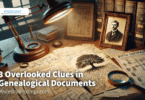One of the really exciting things about genealogy research is coming across an ancient document pertaining to your ancestor, especially if it is one that no one else appears to have discovered. There are plenty of places across the country that keep original documents dating back two and three hundred years (and sometimes more!). You can often access these documents directly, or see copies of them on microfilm or microfiche, depending on the repository you’re using, their policies, and the condition of the documents. Sometimes, you will come across scans of these documents online. Unless they have been transcribed by others, and a transcription is available, you will need to read them yourself. With some ancient documents, this is easier said than done.
Assuming the documents you’re looking at are written in English and don’t require translation (which is a whole other matter), you should be able to make out many of the words. But depending on the neatness of the handwriting on the document, the condition of the document, the time period in which it was written, and the area of the country in which it was written, a lot of it may, at first, seem illegible to you. Don’t let that dissuade you from trying to read the whole thing, though. It may take some time, but you can do it, and in so doing, discover new information on your ancestors you may have otherwise missed.
Remember, there was not always a standard of spelling. The dictionary we use today did not come into common use until the later 1800s. Prior to that, many words were spelled phonetically. This means the people writing the words spelled them as they sounded to them. Sometimes, you will find the same word spelled several different ways in the same document, especially the names of people and towns. When looking at words that don’t seem to make any sense, sound them out like you did when you were learning to read in Kindergarten. You will normally get a good idea of what the word is supposed to be just from doing this one simple thing.
Even if the word doesn’t sound out to be an exact match to any word you know, remember that regional accents played a part in how things were spelled, so go with what the word sounds like the most. It is probably what you think it is, spelled phonetically accounting for accent.
Become familiar with the different ways of lettering things from centuries past. You will come across letters that look odd to you in old documents. That is because different letters and combinations of letters were used to represent different sounds centuries ago. These letterings have fallen out of use, but you can find guides to them online, or buy a reference book on them to take with you when you go to archive buildings to look at old documents.
Some common examples of old-fashioned lettering are the “s” that looks like a lower case cursive “f.” This was used when two “s’s” were side by side in a word. The first “s” would look like a lower case cursive “f,” while the second “s” would look like the lowercase cursive “s” we know today.
“Ye” is another good example. You may think it means “you,” or is an old-fashioned word for “the.” In fact, it is not pronounced how it looks at all. Back in previous centuries, the “ye” together in a word was pronounced “th.” This means “ye” is really pronounced “the” in old documents. It isn’t just an old-fashioned way to say “the,” it is actually pronounced that way. The same is true when you see any word starting with “ye” in an old document. Substitute the “ye” sound for the “th” sound when you’re reading it, and you will get the right word.
There are also a host of old-fashioned abbreviations and accent symbols you may come across in old documents, and you should familiarize yourself with those before you try to translate one.
Sometimes, the handwriting is tiny or messy, and just plain difficult to read, no matter how well you may understand the spelling and lettering of the document. In these cases, you have to spend some time with the document, looking at each letter carefully and comparing it to similar looking letters that are legible in other parts of the document. By comparing letters and seeing how the writer drew them and connected them to other letters (as most old documents are written in cursive), you will eventually get a handle on how this person wrote, and be able to translate their handwriting.
Finally, remember that some words were common in the old days that have since fallen out of use. If you come across a word you simply don’t recognize, write it down and look it up online, either at the archives or later. You will usually find a definition for it if you copied it down correctly. Knowing the definition of old-fashioned words will help you put the final pieces together to allow you to fully read and understand nearly any ancient genealogy document, and learn more about your ancestors than you imagined was possible.






